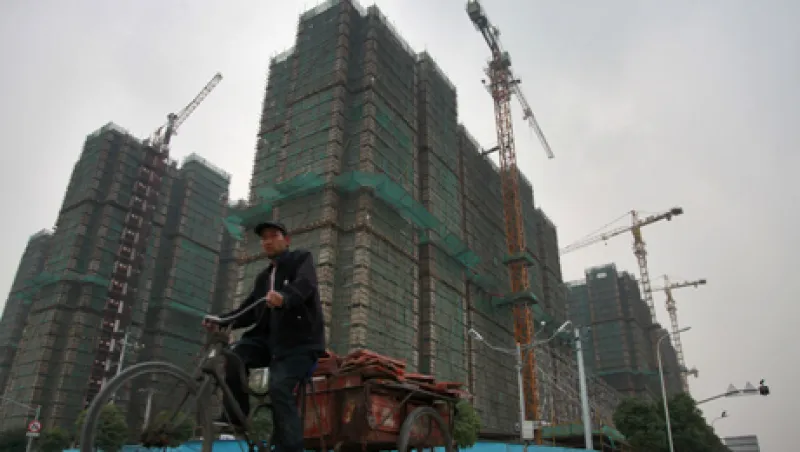Home prices in urban China have risen again — suggesting an end to the year-long decline. But how long can property values appreciate before the iron laws of economics catch up with them?
Prices increased in July in 50 of 70 cities covered by the monthly government survey, with only nine falls. This compares with falls in 52 cities in December, when the slide was most rapid, and signs of a slight overall increase in values in June. The upturn in real estate prices has also boosted property companies’ shares, with China Overseas Land and Investment and China Resources Land both posting increases of around 8 percent since the beginning of July.
Judging by standard measures of house price affordability used in other countries, Chinese property looks irrefutably unaffordable — particularly in the large eastern cities in which much private-sector investment in housing is concentrated. In Beijing, home values are 18 times average local income. In Shanghai they are a staggering 24 times, compared with a little under 10 in Tokyo and around 6 times local income in London and New York. Urban China as a whole is also at the high end, with a multiple of about 8.
However, conventional measures of affordability are not the best guide in China. This is partly because the main purchasers of homes in large urban areas are relatively wealthy Chinese people who are as likely to buy them as an investment play as a place to call home. If one divides prices by the income of the top fifth of people, the results are striking — particularly because of China’ high urban income inequality. The ratio falls to a little below 10 in Beijing, below 8 in Shanghai and about 3 in urban China, according to calculations by Capital Economics, the independent macroeconomic consultancy.
Moreover, the conventional house-price-to-earnings ratio may be a little too static for an economy as dynamic as China’s.
Last week, Chinese Premier Wen Jiabao delivered his last high-profile speech before he and his colleagues give up their 10 years at the helm to make way for a new generation of leaders. With an eye on posterity, he pointed out that over that decade China’s gross domestic product per head leapt from a little over $1,000 to $5,432. Personal incomes have put in a similarly spectacular rise. In some years wages have risen by close to 20 percent — allowing workers to meet mortgage payments for homes by dint of their rapidly rising prosperity.
Moreover, the continuing migration of people to big eastern cities in search of better working opportunities may inject new buyers into the Beijing and Shanghai markets — although many of the new workers will be at the bottom of the economic hierarchy, unable to afford to buy homes
Property prices are also likely to benefit from government reluctance to crack down too hard on the real estate sector. Over the past two years the authorities have used regulations, such as minimum deposit ratios, to cool the market. However, they are unlikely to make such measures considerably stricter, because they do not want to engineer a slowdown in a sector which plays an important role in the economy at a time when China’s annual economic growth for 2012 looks set to be the lowest in 13 years.
“Standard affordability measures in some eastern cities look high compared with many western countries,” says Mike Hennessy, managing director at North Carolina–based Morgan Creek Capital Management. “However, analysts have to allow for the fact that income disparity is very great, and much of the house purchasing in the big eastern cities is by people near the top of the income and wealth scale.” He concludes: “I don’t see the Chinese market as generally in bubble territory, though there are pockets — such as the very high-end Shanghai and Beijing markets — that may border on the bubble-ish because of speculation.”
However, even if Chinese housing is not currently in a bubble, the more in-demand urban districts do show structural characteristics that look set to create bubbles in the future. They are, one might say, bubble-making machines.
Much of the housing stock in these locations is held for speculation rather than habitation, but the rationale for this investment is distinctly shaky. In China — as in Japan, and in sharp contrast to much of Europe — old properties hold little period charm for purchasers and renters. Property has a life of about 30 years before it is deemed unsellable and must be knocked down to allow rebuilding. As a result, the annual depreciation on property is extremely high. Given the high vacancy rates in many Chinese cities — 18 percent of urban property is empty, according to a recent survey by the People’s Bank and Southwestern University of Finance and Economics — many of these properties are earning nothing at all to compensate for the steep depreciation.
Up to a point, nevertheless, these investments make sense for wealthy Chinese people, since the government’s tight control over the economy limits investment opportunities elsewhere — keeping interest rates on bank savings artificially low, for example.
However, the fundamental weakness of empty property as an investment proposition makes it vulnerable to sudden mass sell-offs because of changes in outlook. Any investment boosted by a government-mandated distortion is prone to blow up in one’s face, as the past decade of the U.S. housing market — boosted by federal encouragement — makes clear.
Assuming that continuing rapid wage growth will also keep making the unaffordable affordable is also a little dangerous: China’s breakneck economic expansion will not last forever.
There are, therefore, at least a couple of ticking time bombs in the Chinese property market, though they may not go off for many years.






